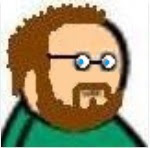April A-to-Z: must-read books
Year Million: Science at the Far
Edge of Knowledge (2008)
Edited by Damien Broderick
(1944-) Australia
Here
are fourteen essays by leading scientists and science writers who were asked to
predict the look of human existence come the year one-million. Their responses
are consistent: The task is impossible but the exercise in trying provides
a remarkable wealth of material to ponder for those more interested in the
question, who are we, than who will win American Idol. They write with generous restraint,
allowing the reader to ponder ramifications and ask the big questions for
themselves.
Dougal Dixon's non-partisan perspectives on carbon dioxide cycles bring some clarity to the contentious global warming arena. Wil McCarthy's handling of matters concerning the rarity of life and of intelligent life and the scope of cosmic time and distance are of critical relevance to the alien question. Journalist Jim Holt delves into the nature of mathematics. Fundamental reality or human invention?
Amara D. Angelica explores the digital and analog natures of all things and probes the inherent compatibility of computers, human beings and galaxies while Robert Bradbury and Rudy Rucker "debate" the eventual restructuring of star systems into habitable super computers versus the eventual rejection of computers as humans meld with nature’s inherent computation.
For those with a view to the parasitic nature of mankind's dominance over the Earth, beware of Robin Hanson's treatment on the plausibility and rapidity of space colonization.
Dr. Steven B. Harris's insights into evolution leave apparent the gaping flaws in any notion of grand design theory while he, Pamela Sargent and Anne Corwin delve into biological science and technology, promoting an inevitable confrontation with polymorphability and immortality. Meanwhile Sean M. Carroll, Gregory Benford and George Zebrowski arouse the greatest life-or-death question of all, exploring the troubling matter of entropy and the fate of the universe.
Dougal Dixon's non-partisan perspectives on carbon dioxide cycles bring some clarity to the contentious global warming arena. Wil McCarthy's handling of matters concerning the rarity of life and of intelligent life and the scope of cosmic time and distance are of critical relevance to the alien question. Journalist Jim Holt delves into the nature of mathematics. Fundamental reality or human invention?
Amara D. Angelica explores the digital and analog natures of all things and probes the inherent compatibility of computers, human beings and galaxies while Robert Bradbury and Rudy Rucker "debate" the eventual restructuring of star systems into habitable super computers versus the eventual rejection of computers as humans meld with nature’s inherent computation.
For those with a view to the parasitic nature of mankind's dominance over the Earth, beware of Robin Hanson's treatment on the plausibility and rapidity of space colonization.
Dr. Steven B. Harris's insights into evolution leave apparent the gaping flaws in any notion of grand design theory while he, Pamela Sargent and Anne Corwin delve into biological science and technology, promoting an inevitable confrontation with polymorphability and immortality. Meanwhile Sean M. Carroll, Gregory Benford and George Zebrowski arouse the greatest life-or-death question of all, exploring the troubling matter of entropy and the fate of the universe.
A passage from the introduction
by Damien Broderick:
My own view is that we will
negotiate the hazards threatening our species. We will not kill ourselves off.
We will not die off from disease. We will wax and wane with all manner of
climate changes, asteroid impacts, runaway technology, and evil robots. We will
persevere… Perhaps this view that we are unkillable–at least as a species–is
naïve. But even if we are to live as long as the average mammalian
species—between 1 and 3 million years—we still have a huge stretch of time
left, for our species is barely a quarter of a million years old. And who says
we are average? My bet is that we will stick around until the very end of
planetary habitability for this already old Earth.
Peter Ward, Future Evolution:
An Illuminated History of Life to Come
A million years—it’s a haunting number,
quite terrifying if you put your imagination to work trying to grasp what it
means, what it implies.
Casting our minds a million years into the past, we find in the wide
world no trace anywhere of familiar, comforting intelligence. Yes, there are
scattered hominids, Homo antecessor, Homo
heidelbergensis, our ancient precursors—but
perhaps they have only rudimentary speech and song, few tools, little in
the way of clothing (although at least they own fire to warm them in the
night), maybe no shelter from the rain or snow other than huddling beneath
bushes or in caves as lightning cracks the sky. We imagine our first true
ancestors to have been nasty, brutish and, if not short, then certainly
short-lived. It is eerie to consider that these protohumans were not entirely
alone, as we are; for they shared their planet with equally brutish cousins—Homo erectus, Homo ergaster, others—who
separated from common ancestors a quarter of a million years earlier.
In our future, we can anticipate a
further splitting of our hereditary line, but on a vaster and stranger scale. A
million years hence, if any of our lineage survive, they will be very different
from how we are today, far more alien to us than we are to early Homo.









































No comments:
Post a Comment